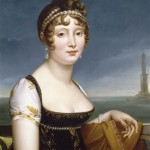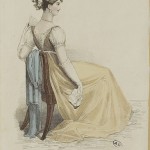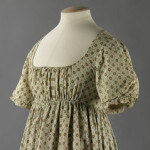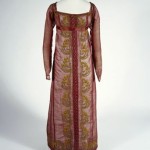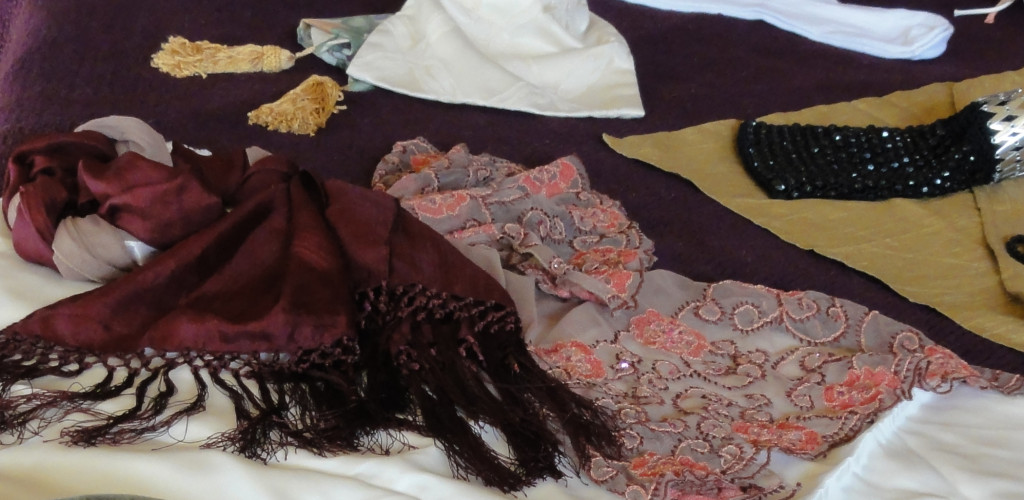When my hair was long, the best up-do I could accomplish myself was the Olive Oyl look when attempting even the simplest bun! Now it’s cut in an angled bob, and the good news is the front is a nice length for some Regency curls around my face.
The most common Regency hair styles are centre-parted, with several ringlets close to the face and a fancy up-do. If you never had to take off your hat, the ringlets would be all you’d need. But if you go indoors, hats come off, so for me and other short-haired gals, other options are a must!
Even though most Regency women had long hair, worn up in public and taken down for nighttime,some had short haircuts. These tended to be combed forward and decorated with a ribbon or bandeau. Update below.
The balance of this post will focus on creating the illusion of the full Regency up-do.
Click on the thumbnails to see larger images that enhance the text of this post.
~
The Ringlets:
How to Style your Medium to Long Bangs into Ringlets
Your hair is straight or almost straight:
- Part clean, damp hair in middle
- Separate hair hold the rest back (a hairband can help):
o If your hair suits curls that sit side-by-side like soldiers, separate in front of your ears.
o If you have tapered bangs, your curls will drop like stair-steps down the side of the face, so separate about one inch back. - Starting at the back (or part for stair-steps), separate a section about 1” by 1”or finger-sized when gathered.
- Spray the first section liberally with hair spray and roll into a cylinder using a curling iron or small-diameter hot roller.
- If you have foam hair rollers the diameter of your finger or so, roll the curl off the iron and onto these, otherwise, secure to your other hair with bobby pins underneath each curl at each end. You can also use rags like the Bennet girls.
- Repeat for all curls, at least two on each side.
o You can also choose to have more curls, asymmetric ones, and/or a couple of curls at the base of your neck.
o The curls can be fatter if you like. Just take a little more hair and use slightly larger roller.
• Let cool and dry completely, then spray again lightly.
• Loosen and drop one curl.
o If it falls too long (long and/or very straight hair), re-attach to the hair underneath with a bobby pin each end and spray liberally with hair spray.
o Make sure the pins are well-hidden since you’re going to leave them in for your event.
Your hair is wavy or curly:
- Start with very wet hair: lightly pat wet hair with towel only until it no longer drips.
- Separate and spray as above.
- Spin hair section around your finger until it’s a medium-loose curl.
- If desired, dry to damp with a diffuser. It will help to set the curl.
- Spray generously again.
- When my hair is done like this, it lasts through a couple of sleeps!
- In the image, the women have allowed their hair to curl naturally.
How to Make Curls in your Short Bangs
Jane Austen wore little curls flat on her forehead.
- Apply an “extreme hold” hair product.
- Pin the curls, then scotch-tape the ends to your face. Remove carefully when dry.
- If you have trouble getting the curl to stay:
o Use a stronger-hold hair product, or
o Learn from Punk rock—yes, you heard that right, Punk in a Regency blog!—by putting a small dab of water-soluble household glue (white glue, art glue, carpenter’s glue) in your wet hand, mix with a few drops of water and/or or your hair product, and then use it instead of gel.
• To remove, soak with a wet cloth until fairly soft, then carefully shampoo out.
• Do not tug too hard, instead, repeat wetting if it does not all come out. - Curls can be made after up-do is formed or headwear is secured, whichever you prefer.
As ubiquitous as they were, curls at the face were not mandatory. Note the two examples of styles where there are no tight curls at the face.
How to Fake Face Curls When You have No Bangs
Long hair, high hairlines, and super-short haircuts are not suited to Regency ringlets.
- A Regency hairpiece seller on Etsy sells ringlets with an alligator clip for $10 each. That adds up if you want a pair or more on each side!
- Curls of hair can be removed from one of those dolls with the “real” hair and “porcelain” face meant to be displayed rather than played with; they’re $8-12 at thrift stores.
o Wrap tape around each curl, close to the doll’s scalp, and snip off. Leave tape in place.
o Pin to your real hair in stair-steps fashion down the side of your hairline, OR tape individual curls to the underside of a hair band, leaving a slight space between each.
o Cover pins/hair band with your long hair, a bandeau, or a turban.
o With a turban, you could even select a new hair colour! - Update at the end of post!
- An alternative: don’t worry about ringlets, and wear a fantastic hair band or turban to distract!
~
The Up-do:
How to Fake it on a Budget when your Hair is too Short for an Up-do
The Regency hair style was long hair dressed close to the head, without any poufy parts other than ringlets.
To get that long hair look, wigs, falls, or hairpieces can be pricey. An Etsy seller has attractive Regency hair pieces in 12 colours, starting at $10 for a single clip-on ringlet, with several styles of full Regency wig with lots of curls for $92. There’s also a $39 curly back bun, and $53 will buy a swirly, pretty one.
Accessories stores have fake hair:
- $12 falls at Claire’s are straight, but can separated with lots of hair spray, then looped and pinned. Hide the ends with a fake braid ($7) from the same store, in four super-basic colours.
- A bun maker ($3) and 1-3 braids work with a short ponytail. Bun hair will be an extra $5.
o Braids can be roped around the bun’s base and then threaded out the centre and left dangly.
o Braid material can be used to make some droops like Jane Bennet in P&P 1995.
o You could wrap a braid around your head, behind your ringlets, like a hairband. This would hide the edges of fake ringlets. -
For bobbed hair, hide wispy hair in back with a wide fillet or hairband tied behind your ringlets, then make certain the rest of your hair is arranged to appear as part of the up-do, perhaps pony-tailed into the bun.
- Slightly longer hair at the hairline that won’t go into a ponytail can be made into additional pin-curls.
- You can also opt to wear a turban, which is covered in the next post. It can be as simple as a pair of intertwined silk scarves, a brooch, and a fancy feather ($20-$50).
You’re Lucky if you have Long Hair!
You can do pretty much anything, including re-creating the styles above without a bun maker or pre-made braids, because you have enough hair yourself.
- Assuming that like me, you can struggle through ringlets, but an up-do behind your head is near impossible, know that we have options!
o The bun-maker with your long hair, plus braid ideas as above.
o Tie your hair in multiple small ponytails and pin to your head, then wear a turban.
o A simple style as in some in the first link below. #1 and #5 are basically ringlets in a ponytail, then loosely pinned around the ponytail.
o I could also manage #6 of the first link below. It would probably end up as a pointy bun like Olive Oyl, which I have seen in some Regency photos.
Online Regency Hair Tutorials:
Seven styles, some harder than others. Please consider putting curls around your face, even if the style you’ve chosen doesn’t have it in the tutorial. You don’t need as many as the first example.
Video; again, make ringlets around the face.
More difficult, and for long hair with no bangs, made with long ringlets. This would be better if they had done a photo or two for each step.
A video for a complicated but beautiful long hairdo.
~
The Accessories
Your hair can be dressed up with accessories regardless of whether you’re using them to hide pins or fake bangs. Fillets, bandeaus, ribbons, combs, flowers, and feathers are the simpler ones, and tiaras, diadems, and jewels were the upscale effects for the best ballrooms!
 As you see in the variety of images in this post, they are optional.
As you see in the variety of images in this post, they are optional.
~
Here are more style ideas and just plain beautiful artwork. Also note the ideas for gowns in all the images! (Click on the thumbnails for larger images.)
~
With luck and good timing, I’ll be able to register for the JASNA AGM in Louisville, Kentucky on October 8-11, 2015; the previous AGM sold out quickly. The theme is “Living in Jane Austen’s World,” and I’m excited about the seminars about her times. That’s where I’ll be wearing the items I’ve collected and re-purposed for this blog.
I’ve had no expert advice during this “Experiment.” “The Boss of Food” from my local JASNA, who’s sewn many a Regency outfit, expressed an interest; I’m sure she would have saved me some mistakes.
Instead, I learned all I know on my own from Regency and other historical web pages, images of real period clothing from museums, and artwork from the time. I felt it made the challenge “real” and helped me communicate through the eyes of a newbie to costuming. Had I not made the mistakes and owned to them, this would not be the blog series it is!
But now, I’m keen to attend some costuming seminars at the AGM. I want to see the Regency clothing construction “up close and in person” for the first time!
I’m in the middle of making my hat, and you’ll be walked through that process in a future post. For the ball, I’ll wear a turban, and I’ve tested out my ability to install one on my own head. We can safely say I won’t embarrass myself too badly! I’ll try a second design for my NEXT POST.
Before the JASNA event, there are a number of Austenesque events to dress up for, and the soonest one just came to my attention: the Regency Springtime Ball in Calgary, Alberta, Canada. It’s the second annual event, organized by Austen-inspired author Melanie Kerr. Her novel Follies Past takes place prior to the start of Pride and Prejudice, with scenes at Ramsgate, similar to my upcoming Letter from Ramsgate.
I wish I’d known of this event sooner, since my sister lives in Calgary, and during my vintage store visits I found several dresses suitable for Regency gowns that were too small for me, but would suit her and my 17-year-old niece. I’d bribe them to join me to the ball. A Regency gown is a good bribe, don’t you think?
~~~
Updates:
1. Some more short hair ideas. The style is called the “Titus,” and it was worn by both men and women.
2. A blogger, Places in Time has a tutorial on how to make your own ringlets from inexpensive fake hair! It looks like you can make a nice set of three ringlets for each side of your face, plus more for the up-do, for around $12.
3. Author and blogger Rachel Knowles has a page dedicated to Headdresses and Hairstyles for Regency on her blog, Regency History. The images, sorted with 4 per year, are from La Belle Assemblée and Ackermann’s Repository for Art and include descriptions from those periodicals.
















